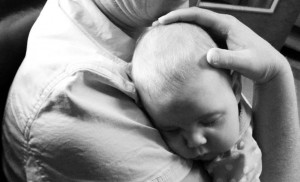Plagiocephaly & Torticollis Treatment
 Plagiocephaly, or misshapen head, can be caused by many things including positioning in-utero, delivery, positioning on the back or being propped upright too early. No matter what the cause, the result is that babies have tightness in the muscles and fascia of the body that lead to decreased mobility and preference for holding head in one direction.
Plagiocephaly, or misshapen head, can be caused by many things including positioning in-utero, delivery, positioning on the back or being propped upright too early. No matter what the cause, the result is that babies have tightness in the muscles and fascia of the body that lead to decreased mobility and preference for holding head in one direction.
Our treatment approach and main objective is to assist babies in gaining a symmetrical head shape without a cranial molding helmet. The secondary objective is to support babies and families who choose cranial molding helmets to get the quickest results. This program consists of 5 main components:
1. Early Detection:
From birth, parents should look down on the top of their newborns head once or twice a week at bath-time. This gives parents the best view of the all around head shape. Parents should check for symmetrical roundness in the back, evenness of the ears, symmetrical width of the head and even forehead. Doing this check at bath-time, when the baby’s hair is wet, gives you the best view, without hair and those adorable cowlicks masking the shape. If symmetries or unevenness are seen, observe baby’s preferences for positioning and how that may be contributing to flatness.
2. Positioning for success:
Babies are not able to hold their head in the middle against gravity until 2-3 months of age. Thus the best position for all infants is horizontal, whether that is on their back (supine), side, or tummy (prone). Babies should only be on their tummies for play and only when they are being watched. Positioning babies upright, even if it is just at 45 degrees should be limited. Sitting on their own or in pieces of equipment such as a Bumbo Chair should be avoided if the baby is not yet crawling on their tummy. Positioning in a standing position should be avoided if the baby is not yet crawling on all fours.
3. Early Intervention:
Therapeutic intervention is so important. If you think your child’s head shape is not symmetrical, do not wait to see if they out-grow it. Have an evaluation as soon as possible to begin the steps to a rounded head shape. This may mean your child only needs some repositioning and a home program or it may mean they need therapy. Either way, the earlier this program is initiated, the quicker the results. Craniosacral Therapy is the recommended intervention. Craniosacral therapy can be provided by a trained clinician. The Lotus Tree currently has several therapists qualified to provide this kind of therapy. Stretching is not a component of this program. Babies resist stretching and parents dislike it too. Babies naturally resist being stretched instead of relaxing. They lack that cognitive override that we have that tells us to relax into a stretch. Movement into mid-line can be facilitated and encouraged gently through therapy, positioning and play.
4. Parent Education:
Knowing what you should do as a parent the other times your baby isn’t in therapy is vital. A home program specific to your baby’s needs, your home and your lifestyle will be developed. This program will be updated and reviewed each session. What you do at home is just as, or more, important than what your baby receives in a therapy session.
5. Tummy time is the right time:
Not only does tummy time reduce the pressures on the back of the head, tummy time is key to typical development of motor skills and the well rounded baby. Tummy time is the first building block in developing binocular vision, hand function, crawling skills and sitting balance. Regular tummy time should start early. Instead of recommending how long tummy time should be, the frequency of opportunity for tummy time is the key. Often taking the time to roll baby onto their tummy after diaper change will ensure they get on their tummies throughout the day.